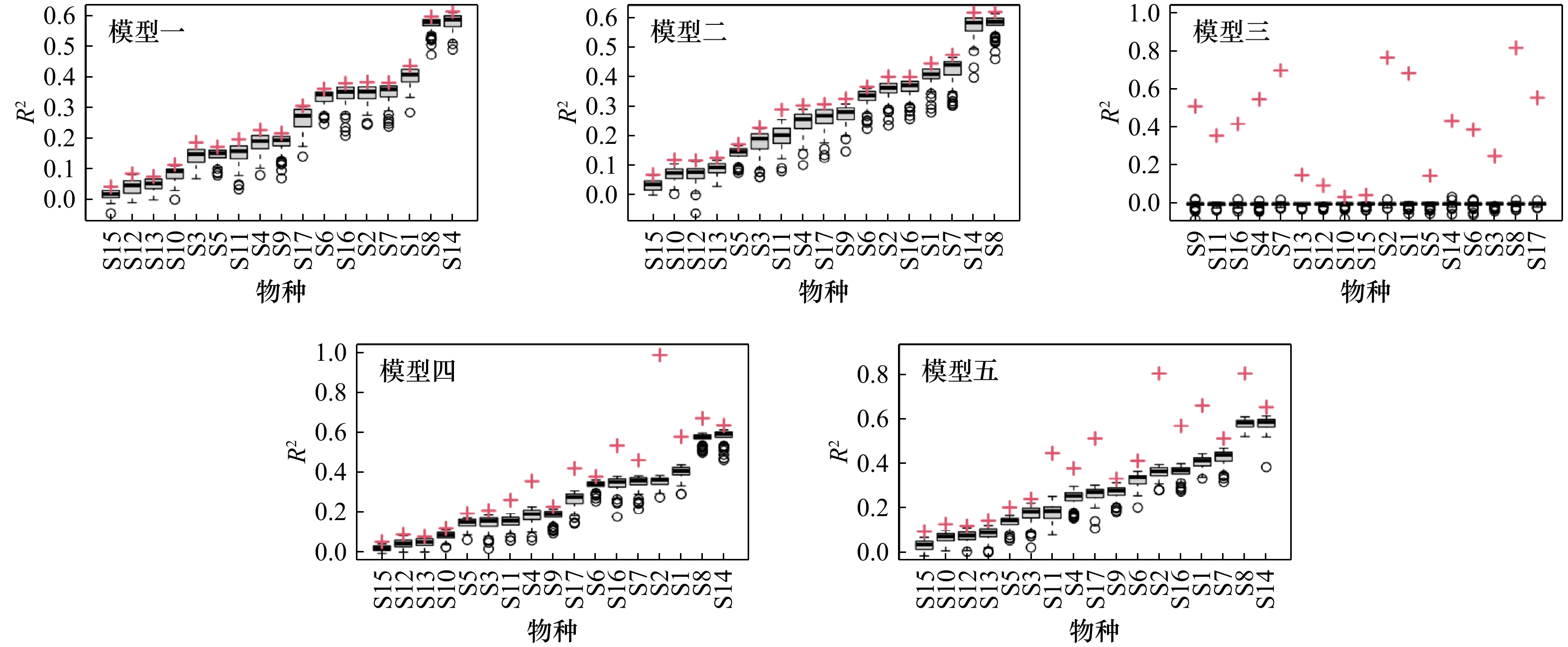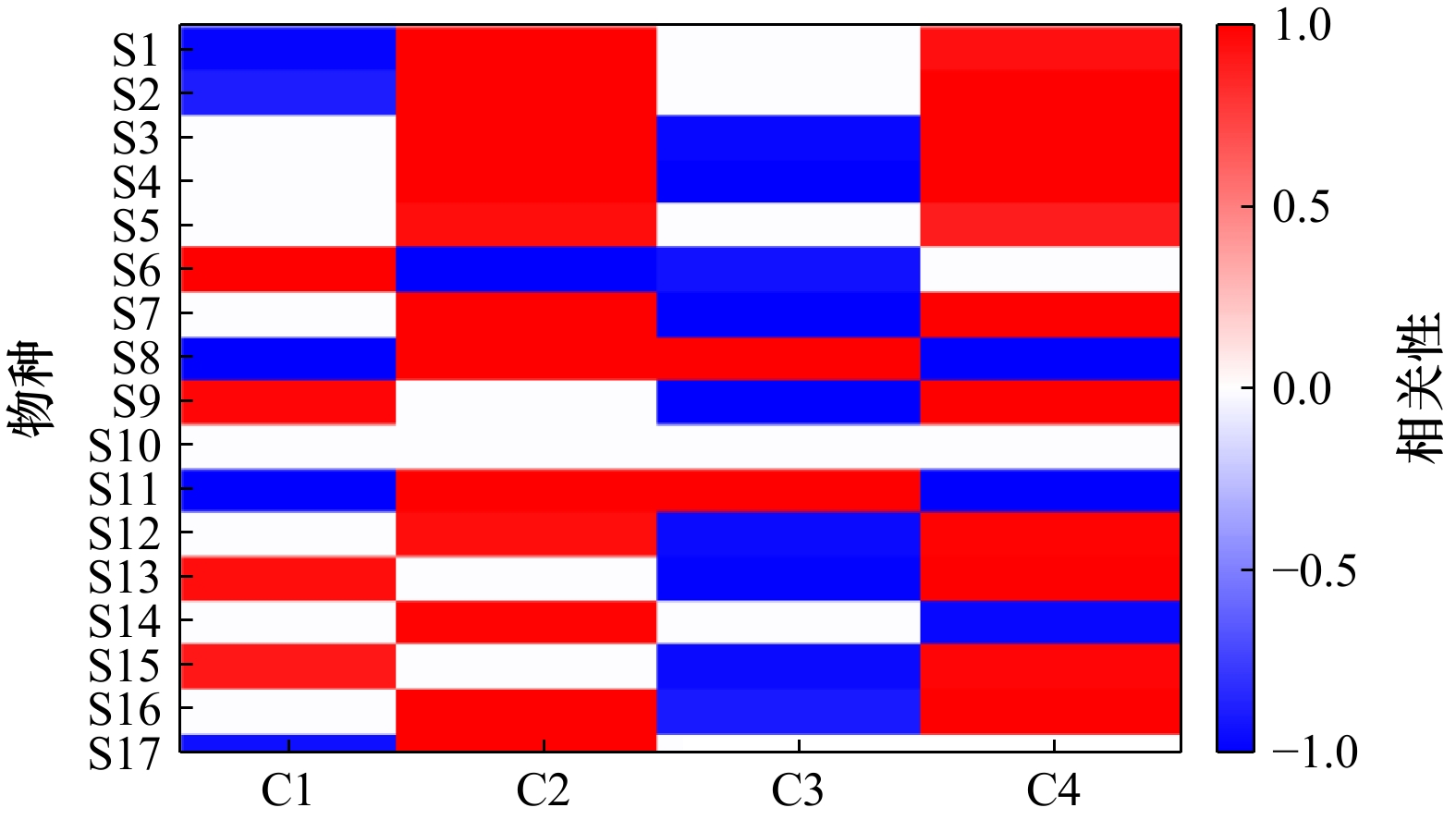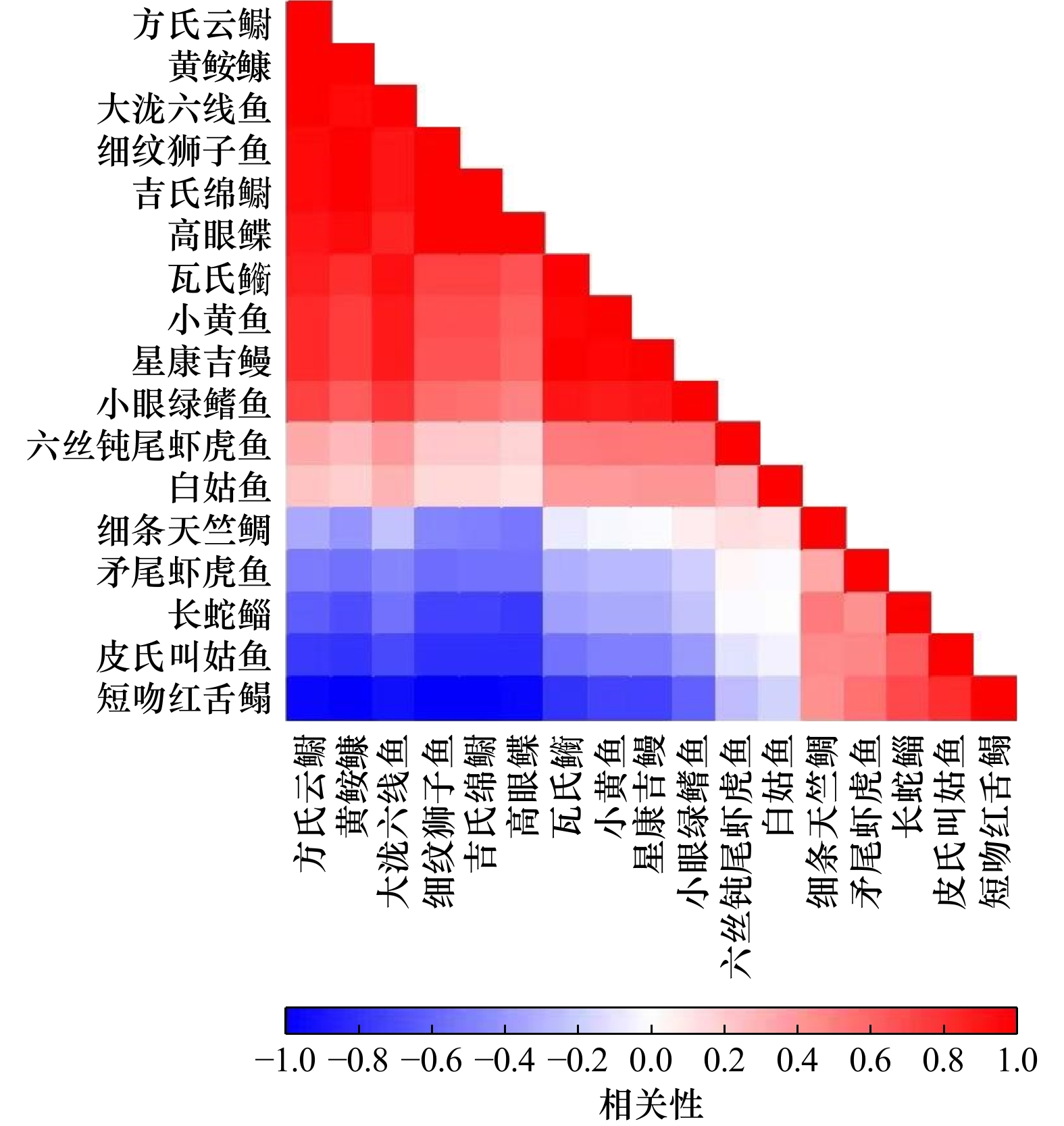Environmental adaptability and interspecific relationships of demersal fishes in the coastal waters of Shandong in summer explored by HMSC models
-
摘要: 传统的物种分布模型很少将种间关系纳入建模框架中,妨碍了对物种栖息分布的准确预测。近年来联合物种分布模型(JSDMs)越来越受到关注,但在海洋领域实际应用仍较为缺乏。本研究根据2017年夏季山东近海底拖网调查数据,结合水深、底层水温和底层盐度等环境数据,采用物种群落层次模型(HMSC)方法研究了山东近海17种底层鱼类与环境因素之间的关系和种间相关性。本研究根据生物与环境之间的线性或非线性关系以及随机效应构建了5种HMSC,并利用广泛适用信息准则(WAIC)等指标以及交叉验证方法,评价了模型拟合程度和预测效果。结果表明,最优模型为包含随机效应的非线性模型(模型五),非线性模型优于线性模型,且在模型中考虑种间关系能明显地提高模型的拟合效果。温度是影响山东近海底层鱼类分布的主要因素,占平均可解释方差的51.4%,其次是水深和随机效应,分别占35.7%和12.8%。山东近海大部分底层鱼类与水深存在显著线性正相关关系,而与水温存在显著的非线性关系。底层鱼类种间具有显著相关性,按其相关性的正负可大致分为3组,表明种间关系在预测物种分布方面的作用不容忽视。本研究建议,在建模中应同时考虑非生物因素和生物之间的相互关系,研究结果为预测渔业资源栖息分布提供了重要参考。
-
关键词:
- 联合物种分布模型(JSDMs) /
- 物种群落层次模型(HMSC) /
- 种间关系 /
- 模型比较 /
- 交叉验证
Abstract: Traditional species distribution models rarely incorporate interspecific relationships into the modeling framework, which hinders their predictions of habitat distributions. In recent years, joint species distribution models (JSDMs) have drawn increasing attentions, but their practical applications remain rare in the marine realm. In this study, we used the HMSC (hierarchical modelling of species communities) method to study their relationships between 17 demersal fish species and environmental factors and the interspecific correlation. The model was built on the basis of bottom trawling data collected in the coastal waters of Shandong in summer, 2017, including the environmental data of water depth, bottom water temperature and bottom water salinity. Five variants of HMSC models were developed with respect to the linear or nonlinear relationships between species and the environmental variables and the exists of random effects, and WAIC and other indicators as well as cross-validation were used to evaluate the performances of fitting and prediction of these models. The results showed that the optimal model was the one incorporating nonlinear relationships and random effects (Model 5). The nonlinear models were generally superior to the linear models, and including the interspecific relationships in the model could improve model fitting performances. Temperature was the main factor influencing the distribution of demersal fishes in the coastal waters of Shandong, accounting for 51.4% of the mean explained variance, followed by water depth and random effects, which accounted for 35.7% and 12.8% explained variance, respectively. There were significant linear positive correlations between most demersal fishes and water depth, and significant nonlinear relationships with water temperature. There were significant interspecific correlations among the demersal fishes, which could be roughly divided into three groups according to the sign of the correlations, indicating that the interspecies relationships played an important role in shaping species distributions. This study suggested that the abiotic factors and biotic factors should be integrated in species distribution modeling, and our results might provide a guideline for the prediction of habitat distribution of fishery resources. -
图 2 山东近海主要底层鱼类5个HMSC模型的R2比较
箱线图表示使用交叉验证的模型预测性的R2;红色十字表示模型拟合度的R2;横坐标为17个物种(表1)
Fig. 2 R2comparison of five HMSC models of main demersal fishes in the coastal waters of Shandong
The boxplots represent R2 in model prediction using cross validation; the red cross represents R2 in model fitting; the x-coordinate denotes 17 species (Tab.1)
图 4 物种对环境因子响应的显著性
纵坐标分别代表17种底层鱼类(表1);横坐标中C1为截距,C2为水深对应的回归系数,C3和C4分别为SBT一次项和二次项对应的β参数;红色表示物种与环境具有显著正相关,蓝色表示物种与环境具有显著负相关,白色表示物种与环境没有显著相关性
Fig. 4 Significance of species responses to environmental factors
The y-coordinate represents 17 species of bottom fishes respectively (Tab.1); in the x-coordinate, C1 is the intercept, C2 is the regression coefficient corresponding to the water depth, C3 and C4 are the β parameters corresponding to the primary and secondary terms of SBT, respectively; red indicates a significant positive correlation between species and environment, blue indicates a significant negative correlation between species and environment, white indicates no significant correlation between
species and environment 表 1 山东近海17种主要底层鱼类
Tab. 1 The major 17 species of demersal fishes in the coastal water of Shandong
编号 物种 学名 平均标准化生物量/
(kg·h−1)S1 方氏云鳚 Pholis fangi 2.312 S2 大泷六线鱼 Hexagrammos otakii 1.477 S3 小黄鱼 Pseudosciaena polyactis 0.643 S4 星康吉鳗 Conger myriaster 0.563 S5 六丝钝尾虾虎鱼 Chaeturichthys hexanema 0.313 S6 短吻红舌鳎 Cynoglossus joyneri 0.049 S7 小眼绿鳍鱼 Chelidonichthys spinosus 2.543 S8 细纹狮子鱼 Liparis tanakae 5.793 S9 细条天竺鲷 Apogonichthys lineatus 0.392 S10 矛尾虾虎鱼 Chaeturichthys stigmatias 0.162 S11 吉氏绵鳚 Enchelyopus gilli 0.332 S12 白姑鱼 Argyrosomus argentatus 0.993 S13 长蛇鲻 Saurida elongata 0.341 S14 高眼鲽 Cleisthenes herzensteini 0.457 S15 皮氏叫姑鱼 Johnius belangeri 0.051 S16 瓦氏鴨 Callionymus valenciennei 0.262 S17 黄鮟鱇 Lophius litulon 4.993 表 2 山东近海主要底层鱼类栖息分布的最优模型
Tab. 2 Optimal models for the habitat distribution of main bottom fishes in the coastal waters of Shandong
模型类型 物种与环境
的关系是否存在
随机效应环境变量 模型一 线性 否 Depth+SBT 模型二 非线性 否 Depth+SBT+SBT2 模型三 无 是 1 模型四 线性 是 Depth+SBT 模型五 非线性 是 Depth+SBT+SBT2 表 3 山东近海主要底层鱼类5个HMSC模型的参数比较
Tab. 3 Parameter comparison of five HMSC models for the main demersal fishes in the coastal waters of Shandong
模型类型 WAIC ess 平均 (β) psrf 平均 (β) ess 平均 ($\varOmega $) psrf 平均 ($\varOmega $) 模型一 无 2 073.04 1.00 模型二 无 2 032.82 1.00 模型三 17 876.67 833.14 1.86 模型四 2 107.11 1 935.82 1.00 1 202.29 1.01 模型五 1 817.33 2 035.90 1.01 1 943.30 1.00 -
[1] Chu C, Mandrak N E, Minns C K. Potential impacts of climate change on the distributions of several common and rare freshwater fishes in Canada[J]. Diversity and Distributions, 2005, 11(4): 299−310. doi: 10.1111/j.1366-9516.2005.00153.x [2] Xenopoulos M A, Lodge D M, Alcamo J, et al. Scenarios of freshwater fish extinctions from climate change and water withdrawal[J]. Global Change Biology, 2005, 11(10): 1557−1564. doi: 10.1111/j.1365-2486.2005.001008.x [3] Bond N, Thomson J, Reich P, et al. Using species distribution models to infer potential climate change-induced range shifts of freshwater fish in south-eastern Australia[J]. Marine and Freshwater Research, 2011, 62(9): 1043−1061. doi: 10.1071/MF10286 [4] DeWeber J T, Wagner T. Probabilistic measures of climate change vulnerability, adaptation action benefits, and related uncertainty from maximum temperature metric selection[J]. Global Change Biology, 2018, 24(6): 2735−2748. doi: 10.1111/gcb.14101 [5] Harbor C S, Li N Y. Cold spring harbor symposia on quantitative biology[C]//Cold Spring Harb Symp Quant Biol, [S.l: s.n.]: 1979, 43: 1197−1208. [6] Wisz M S, Pottier J, Kissling W D, et al. The role of biotic interactions in shaping distributions and realised assemblages of species: implications for species distribution modelling[J]. Biological Reviews, 2013, 88(1): 15−30. doi: 10.1111/j.1469-185X.2012.00235.x [7] 朱媛君, 山丹, 张晓, 等. 揭示群落结构及其环境响应的联合物种分布模型的研究进展[J]. 应用生态学报, 2018, 29(12): 4217−4225.Zhu Yuanjun, Shan Dan, Zhang Xiao, et al. Advances in joint species distribution models to reveal community structure and its environmental response[J]. Chinese Journal of Applied Ecology, 2018, 29(12): 4217−4225. [8] Harris D J. Generating realistic assemblages with a joint species distribution model[J]. Methods in Ecology and Evolution, 2015, 6(4): 465−473. doi: 10.1111/2041-210X.12332 [9] Latimer A M, Banerjee S, Sang H Jr, et al. Hierarchical models facilitate spatial analysis of large data sets: a case study on invasive plant species in the northeastern United States[J]. Ecology Letters, 2009, 12(2): 144−154. doi: 10.1111/j.1461-0248.2008.01270.x [10] Clark J S, Bell D M, Kwit M C, et al. Competition-interaction landscapes for the joint response of forests to climate change[J]. Global Change Biology, 2014, 20(6): 1979−1991. doi: 10.1111/gcb.12425 [11] Clark J S, Gelfand A E, Woodall C W, et al. More than the sum of the parts: forest climate response from joint species distribution models[J]. Ecological Applications, 2014, 24(5): 990−999. doi: 10.1890/13-1015.1 [12] Norberg A, Abrego N, Blanchet F G, et al. A comprehensive evaluation of predictive performance of 33 species distribution models at species and community levels[J]. Ecological Monographs, 2019, 89(3): e01370. [13] 崔毅, 马绍赛, 李云平, 等. 莱州湾污染及其对渔业资源的影响[J]. 海洋水产研究, 2003, 24(1): 35−41.Cui Yi, Ma Shaosai, Li Yunping, et al. Pollution situation in the Laizhou Bay and its effects on fishery resources[J]. Progress in Fishery Sciences, 2003, 24(1): 35−41. [14] 中华人民共和国国家质量监督检验检疫总局, 中国国家标准化管理委员会. GB/T 12763.6−2007, 海洋调查规范 第6部分: 海洋生物调查[S]. 北京: 中国标准出版社, 2007.General Administration of Quality Supervision, Inspection and Quarantine of the China, Standardization Administration of China. GB/T 12763.6−2007, Specifications for oceanographic survey-Part 6: marine biological survey[S]. Beijing: Standards Press of China, 2007. [15] Chen Changsheng, Gao Guoping, Zhang Yu, et al. Circulation in the Arctic Ocean: results from a high-resolution coupled ice-sea nested Global-FVCOM and Arctic-FVCOM system[J]. Progress in Oceanography, 2016, 141: 60−80. doi: 10.1016/j.pocean.2015.12.002 [16] 林忠辉, 莫兴国, 李宏轩, 等. 中国陆地区域气象要素的空间插值[J]. 地理学报, 2002, 57(1): 47−56. doi: 10.11821/xb200201006Lin Zhonghui, Mo Xingguo, Li Hongxuan, et al. Comparison of three spatial interpolation methods for climate variables in China[J]. Acta Geographica Sinica, 2002, 57(1): 47−56. doi: 10.11821/xb200201006 [17] 王政权. 地统计学及在生态学中的应用[M]. 北京: 科学出版社, 1999: 1−197.Wang Zhengquan. Application of Geostatistics in Ecology[M]. Beijing: Science Press, 1999: 1−197. [18] Warton D I, Blanchet F G, O’Hara R B, et al. So many variables: joint modeling in community ecology[J]. Trends in Ecology & Evolution, 2015, 30(12): 766−779. [19] Ovaskainen O, Hottola J, Siitonen J. Modeling species co-occurrence by multivariate logistic regression generates new hypotheses on fungal interactions[J]. Ecology, 2010, 91(9): 2514−2521. doi: 10.1890/10-0173.1 [20] Kissling W D, Dormann C F, Groeneveld J, et al. Towards novel approaches to modelling biotic interactions in multispecies assemblages at large spatial extents[J]. Journal of Biogeography, 2012, 39(12): 2163−2178. doi: 10.1111/j.1365-2699.2011.02663.x [21] Pollock L J, Tingley R, Morris W K, et al. Understanding co-occurrence by modelling species simultaneously with a Joint Species Distribution Model (JSDM)[J]. Methods in Ecology and Evolution, 2014, 5(5): 397−406. doi: 10.1111/2041-210X.12180 [22] Skrondal A, Rabe-Hesketh S. Generalized Latent Variable Modeling: Multilevel, Longitudinal, and Structural Equation Models[M]. New York: Chapman and Hall/CRC, 2004. [23] Ovaskainen O, Abrego N, Halme P, et al. Using latent variable models to identify large networks of species-to-species associations at different spatial scales[J]. Methods in Ecology and Evolution, 2016, 7(5): 549−555. doi: 10.1111/2041-210X.12501 [24] Ovaskainen O, Tikhonov G, Norberg A, et al. How to make more out of community data? A conceptual framework and its implementation as models and software[J]. Ecology Letters, 2017, 20(5): 561−576. doi: 10.1111/ele.12757 [25] Ovaskainen O, Tikhonov G, Dunson D, et al. How are species interactions structured in species-rich communities? A new method for analysing time-series data[J]. Proceedings of the Royal Society B: Biological Sciences, 2017, 284(1855): 20170768. doi: 10.1098/rspb.2017.0768 [26] Ovaskainen O, Roy D B, Fox R, et al. Uncovering hidden spatial structure in species communities with spatially explicit joint species distribution models[J]. Methods in Ecology and Evolution, 2016, 7(4): 428−436. doi: 10.1111/2041-210X.12502 [27] Beverton R J H, Holt S J. On the Dynamics of Exploited Fish Populations[M]. Dordrecht: Springer Science & Business Media, 2012. [28] Bozdogan H. Model selection and Akaike’s information criterion (AIC): the general theory and its analytical extensions[J]. Psychometrika, 1987, 52(3): 345−370. doi: 10.1007/BF02294361 [29] Tikhonov G, Opedal Ø H, Abrego N, et al. Hmsc 3.0: getting started with Hmsc: high-dimensional multivariate models[R]. [S.l: s.n.]: 2019, 1−26. [30] Hyndman R J, Koehler A B. Another look at measures of forecast accuracy[J]. International Journal of Forecasting, 2006, 22(4): 679−688. doi: 10.1016/j.ijforecast.2006.03.001 [31] Xu Binduo, Zhang Chongliang, Xue Ying, et al. Optimization of sampling effort for a fishery-independent survey with multiple goals[J]. Environmental Monitoring and Assessment, 2015, 187(5): 252. doi: 10.1007/s10661-015-4483-9 [32] 成庆泰, 周才武. 山东鱼类志[M]. 济南: 山东科学技术出版社, 1997: 256−257.Cheng Qingtai, Zhou Caiwu. The Fishes of Shandong Province[M]. Ji’nan: Shandong Science and Technology Press, 1997: 256−257. [33] Guisan A, Thuiller W. Predicting species distribution: offering more than simple habitat models[J]. Ecology Letters, 2005, 8(9): 993−1009. doi: 10.1111/j.1461-0248.2005.00792.x [34] 范永东. 模型选择中的交叉验证方法综述[D]. 太原: 山西大学, 2013.Fan Yongdong. A summary of cross-validation in model selection[D]. Taiyuan: Shanxi University, 2013. [35] Mod H K, Le Roux P C, Guisan A, et al. Biotic interactions boost spatial models of species richness[J]. Ecography, 2015, 38(9): 913−921. doi: 10.1111/ecog.01129 [36] Zhang Chongliang, Xu Binduo, Xue Ying, et al. Evaluating multispecies survey designs using a joint species distribution model[J]. Aquaculture and Fisheries, 2020, 5(3): 156−162. doi: 10.1016/j.aaf.2019.11.002 [37] 吴桢, 张崇良, 薛莹, 等. 山东近海底层鱼类资源空间异质性[J]. 海洋学报, 2022, 44(2): 21−28.Wu Zhen, Zhang Chongliang, Xue Ying, et al. Spatial heterogeneity of demersal fish in the offshore waters of Shandong[J]. Haiyang Xuebao, 2022, 44(2): 21−28. [38] 张秋华, 程家骅, 徐汉祥, 等. 东海区渔业资源及其可持续利用[M]. 上海: 复旦大学出版社, 2007: 47-59.Zhang Qiuhua, Cheng Jiahua, Xu Hanxiang, et al. Fishery Resources and Sustainable Utilization in the East China Sea Region[M]. Shanghai: Fudan University Press, 2007: 47−59. [39] 陈新军. 渔业资源与渔场学[M]. 2版. 北京: 海洋出版社, 2014.Chen Xinjun. Fisheries Resources and Fishing Grounds[M]. 2nd ed. Beijing: China Ocean Press, 2014. [40] 朱元鼎, 金鑫波. 中国杜父鱼类的地理分布和区系特征[J]. 海洋与湖沼, 1965, 7(3): 235−252.Zhu Yuanding, Jin Xinbo. The geographical distribution and faunal characteristics of cottoid fishes of China[J]. Oceanologia et Limnologia Sinica, 1965, 7(3): 235−252. [41] 毕远溥. 方氏云鳚渔业生物学及其在辽宁沿海的渔业[J]. 水产科学, 2005, 24(9): 27−28.Bi Yuanpu. Biology and its fishery of Fang’s blenny Enedrias fangi Wang et Wang in offshore in Liaoning Province[J]. Fisheries Science, 2005, 24(9): 27−28. [42] 薛莹, 徐宾铎, 高天翔, 等. 北黄海秋季黄鮟鱇摄食习性的初步研究[J]. 中国海洋大学学报(自然科学版), 2010, 40(9): 39−44.Xue Ying, Xu Binduo, Gao Tianxiang, et al. Preliminary study on the feeding Habit of Lophius litulon during autumn in the North Yellow Sea[J]. Periodical of Ocean University of China, 2010, 40(9): 39−44. [43] 纪东平, 卞晓东, 宋娜, 等. 荣成俚岛大泷六线鱼摄食生态研究[J]. 水产学报, 2014, 38(9): 1399−1409.Ji Dongping, Bian Xiaodong, Song Na, et al. Feeding ecology of Hexagrammos otakii in Lidao Rongcheng[J]. Journal of Fisheries of China, 2014, 38(9): 1399−1409. [44] 张波, 金显仕, 戴芳群. 黄海中南部细纹狮子鱼的摄食习性及其变化[J]. 水产学报, 2011, 35(8): 1199−1207.Zhang Bo, Jin Xianshi, Dai Fangqun. Feeding habits and their variation of seasnail (Liparis tanakae) in the central and southern Yellow Sea[J]. Journal of Fisheries of China, 2011, 35(8): 1199−1207. [45] 张波. 黄海中部高眼鲽的摄食及随体长的变化[J]. 应用生态学报, 2007, 18(8): 1849−1854.Zhang Bo. Diet composition and ontogenetic variation in feeding habits of Cleithenes herzensteini in central Yellow Sea[J]. Chinese Journal of Applied Ecology, 2007, 18(8): 1849−1854. [46] 金海卫, 薛利建, 朱增军, 等. 东海和黄海南部细条天竺鲷的摄食习性[J]. 海洋渔业, 2012, 34(4): 361−370. doi: 10.3969/j.issn.1004-2490.2012.04.001Jin Haiwei, Xue Lijian, Zhu Zengjun, et al. Feeding habits of Apogon lineatus in the East China Sea and southern Yellow Sea[J]. Marine Fisheries, 2012, 34(4): 361−370. doi: 10.3969/j.issn.1004-2490.2012.04.001 [47] 邓景耀, 孟田湘, 任胜民. 渤海鱼类食物关系的初步研究[J]. 生态学报, 1986, 6(4): 356−364.Deng Jingyao, Meng Tianxiang, Ren Shengmin. Food web of fishes in Bohai Sea[J]. Acta Ecologica Sinica, 1986, 6(4): 356−364. [48] 徐兆礼. 兴化湾和闽江口海域春夏季鱼类区系特征[J]. 生物多样性, 2011, 19(1): 79−84. doi: 10.3724/SP.J.1003.2011.06113Xu Zhaoli. Comparison of fish fauna of two different waters (Minjiang Estuary and Xinghua Bay) of the East China Sea during spring and summer[J]. Biodiversity Science, 2011, 19(1): 79−84. doi: 10.3724/SP.J.1003.2011.06113 [49] 陈皖, 任晓明, 徐宾铎, 等. 基于稳定同位素研究海州湾短吻红舌鳎的摄食生态[J]. 应用生态学报, 2021, 32(3): 1080−1086.Chen Wan, Ren Xiaoming, Xu Binduo, et al. Understanding the feeding ecology of Cynoglossus joyneri in Haizhou Bay based on stable isotope analysis[J]. Chinese Journal of Applied Ecology, 2021, 32(3): 1080−1086. [50] 高元新, 隋昊志, 任晓明, 等. 基于胃含物和稳定同位素研究海州湾长蛇鲻的摄食习性[J]. 应用生态学报, 2020, 31(12): 4277−4283. doi: 10.13287/j.1001-9332.202012.038Gao Yuanxin, Sui Haozhi, Ren Xiaoming, et al. Feeding habits of Saurida elongata in Haizhou Bay, Shandong, China, based on stomach contents and stable isotope[J]. Chinese Journal of Applied Ecology, 2020, 31(12): 4277−4283. doi: 10.13287/j.1001-9332.202012.038 [51] 林龙山, 张静, 宋普庆, 等. 东山湾及其邻近海域常见游泳动物[M]. 北京: 海洋出版社, 2013: 12.Lin Longshan, Zhang Jing, Song Puqing, et al. Nekton in Dongshan Bay and Adjacent Areas, China[M]. Beijing: China Ocean Press, 2013: 12. [52] 许仲林, 彭焕华, 彭守璋. 物种分布模型的发展及评价方法[J]. 生态学报, 2015, 35(2): 557−567.Xu Zhonglin, Peng Huanhua, Peng Shouzhang. The development and evaluation of species distribution models[J]. Acta Ecologica Sinica, 2015, 35(2): 557−567. [53] Tikhonov G, Duan L, Abrego N, et al. Computationally efficient joint species distribution modeling of big spatial data[J]. Ecology, 2020, 101(2): e02929. [54] Peterson A T, Soberón J, Pearson R G, et al. Ecological Niches and Geographic Distributions (MPB-49)[M]. Princeton: Princeton University Press, 2011. -





 下载:
下载:




